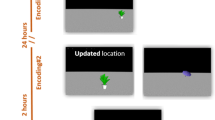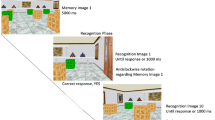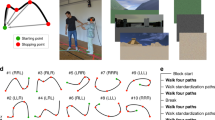Abstract
Ageing effects on spatial navigation are characterized mainly in terms of impaired allocentric strategies. However, an alternative hypothesis is that navigation difficulties in aged people are associated with deficits in processing and encoding spatial cues. We tested this hypothesis by studying how geometry and landmark cues control navigation in young and older adults in a real, ecological environment. Recordings of body and gaze dynamics revealed a preference for geometry-based navigation in older adults, and for landmark-based navigation in younger ones. While cue processing was associated with specific fixation patterns, advanced age manifested itself in a longer reorientation time, reflecting an unbalanced exploration–exploitation trade-off in scanning policies. Moreover, a battery of tests revealed a specific cognitive deficit in older adults with geometric preference. These results suggest that allocentric strategy deficits in ageing can result from difficulties related to landmark coding, and predict recovery of allocentric strategies in geometrically polarized environments.
This is a preview of subscription content, access via your institution
Access options
Access Nature and 54 other Nature Portfolio journals
Get Nature+, our best-value online-access subscription
$29.99 / 30 days
cancel any time
Subscribe to this journal
Receive 12 digital issues and online access to articles
$119.00 per year
only $9.92 per issue
Buy this article
- Purchase on Springer Link
- Instant access to full article PDF
Prices may be subject to local taxes which are calculated during checkout







Similar content being viewed by others
Data availability
The datasets generated and analysed during the current study are available from the corresponding author upon request.
Code availability
All custom software can be found at http://www.aging-vision-action.fr/ava_files/silversight/custom.software.zip.
References
Lester, A. W., Moffat, S. D., Wiener, J. M., Barnes, C. A. & Wolbers, T. The aging navigational system. Neuron 95, 1019–1035 (2017).
Moffat, S. D., Elkins, W. & Resnick, S. M. Age differences in the neural systems supporting human allocentric spatial navigation. Neurobiol. Aging 27, 965–972 (2006).
Bates, S. L. & Wolbers, T. How cognitive aging affects multisensory integration of navigational cues. Neurobiol. Aging 35, 2761–2769 (2014).
Kunz, L. et al. Reduced grid-cell-like representations in adults at genetic risk for Alzheimer’s disease. Science 350, 430–433 (2015).
Gazova, I. et al. Spatial navigation—a unique window into physiological and pathological aging. Front. Aging Neurosci. 4, 16 (2012).
Lord, S. R., Rogers, M. W., Howland, A. & Fitzpatrick, R. Lateral stability, sensorimotor function and falls in older people. J. Am. Geriatr. Soc. 47, 1077–1081 (1999).
Anderson, P. G., Nienhuis, B., Mulder, T. & Hulstijn, W. Are older adults more dependent on visual information in regulating self-motion than younger adults? J. Mot. Behav. 30, 104–113 (1998).
Lövdén, M., Schellenbach, M., Grossman-Hutter, B., Krüger, A. & Lindenberger, U. Environmental topography and postural control demands shape aging-associated decrements in spatial navigation performance. Psychol. Aging 20, 683–694 (2005).
Sekuler, R., Hutman, L. & Owsley, C. Human aging and spatial vision. Science 209, 1255–1256 (1980).
Warren, W. H., Blackwell, aW. & Morris, M. W. Age differences in perceiving the direction of self-motion from optical flow. J. Gerontol. 44, 147–153 (1989).
Mahmood, O., Adamo, D., Briceno, E. & Moffat, S. D. Age differences in visual path integration. Behav. Brain Res. 205, 88–95 (2009).
Klencklen, G., Després, O. & Dufour, A. What do we know about aging and spatial cognition? Reviews and perspectives. Ageing Res. Rev. 11, 123–135 (2012).
Eyler, L. T., Sherzai, A., Kaup, A. R. & Jeste, D. V. A review of functional brain imaging correlates of successful cognitive aging. Biol. Psychiatry 70, 115–122 (2011).
Konishi, K. & Bohbot, V. D. Spatial navigational strategies correlate with gray matter in the hippocampus of healthy older adults tested in a virtual maze. Front. Aging Neurosci. 5, 1–8 (2013).
Iaria, G., Palermo, L., Committeri, G. & Barton, J. J. S. Age differences in the formation and use of cognitive maps. Behav. Brain Res. 196, 187–191 (2009).
Harris, M. A., Wiener, J. M. & Wolbers, T. Aging specifically impairs switching to an allocentric navigational strategy. Front. Aging Neurosci. 4, 1–9 (2012).
Foo, P., Warren, W. H., Duchon, A. & Tarr, M. J. Do humans integrate routes into a cognitive map? Map- versus landmark-based navigation of novel shortcuts. J. Exp. Psychol. Learn. Mem. Cogn. 31, 195–215 (2005).
Bosco, A., Picucci, L., Caffò, A. O., Lancioni, G. E. & Gyselinck, V. Assessing human reorientation ability inside virtual reality environments: the effects of retention interval and landmark characteristics. Cogn. Process. 9, 299–309 (2008).
Newcombe, N. S. & Ratliff, R. Reorienting when cues conflict: evidence for an adaptive-combination view. Psychol. Sci. 19, 1301–1307 (2008).
Wegman, J., Tyborowska, A. & Janzen, G. Encoding and retrieval of landmark-related spatial cues during navigation: an fMRI study. Hippocampus 24, 853–868 (2014).
Gallistel, C. R. The Organization of Learning (MIT Press, 1990).
Cheng, K. A purely geometric module in the rat’s spatial representation. Cognition 23, 149–178 (1986).
Doeller, C. F. & Burgess, N. Distinct error-correcting and incidental learning of location relative to landmarks and boundaries. Proc. Natl Acad. Sci. USA 105, 5909–5914 (2008).
Pearce, J. M. The 36th Sir Frederick Bartlett Lecture: an associative analysis of spatial learning. Q. J. Exp. Psychol. 62, 1665–1684 (2009).
Presson, C. C. & Montello, D. R. Points of reference in spatial cognition. Stalking the elusive landmark. Br. J. Dev. Psychol. 6, 378–381 (1988).
Hermer, L. & Spelke, E. A geometric process for spatial reorientation in young children. Nature 370, 57–59 (1994).
Learmonth, A. E., Newcombe, N. S., Sheridan, N. & Jones, M. Why size counts: children’s spatial reorientation in large and small enclosures. Dev. Sci. 11, 414–426 (2008).
Hermer-Vazquez, L., Spelke, E. S. & Katsnelson, A. S. Sources of flexibility in human cognition: dual-task studies of space and language. Cogn. Psychol. 39, 3–36 (1999).
Cheng, K., Huttenlocher, J. & Newcombe, N. S. 25 years of research on the use of geometry in spatial reorientation: a current theoretical perspective. Psychon. Bull. Rev. 20, 1033–1054 (2013).
Picucci, L., Caffò, A. O. & Bosco, A. Age and sex differences in a virtual version of the reorientation task. Cogn. Process. 10, 272–275 (2009).
Schuck, N. W., Doeller, C. F., Polk, T. A., Lindenberger, U. & Li, S.-C. Human aging alters the neural computation and representation of space. Neuroimage I, 141–150 (2015).
Adamo, D. E., Briceño, E. M., Sindone, Ja, Alexander, N. B. & Moffat, S. D. Age differences in virtual environment and real world path integration. Front. Aging Neurosci. 4, 26 (2012).
Harris, Ma & Wolbers, T. Ageing effects on path integration and landmark navigation. Hippocampus 22, 1770–1780 (2012).
Sturz, B. R., Kilday, Za & Bodily, K. D. Does constraining field of view prevent extraction of geometric cues for humans during virtual-environment reorientation? J. Exp. Psychol. Anim. Behav. Process. 39, 390–396 (2013).
Rolls, E. T. Spatial view cells and the representation of place in the primate hippocampus. Hippocampus 9, 467–480 (1999).
Ekstrom, A. D. Why vision is important to how we navigate. Hippocampus 25, 731–735 (2015).
Killian, N. J., Jutras, M. J. & Buffalo, E. A. A map of visual space in the primate entorhinal cortex. Nature 5, 3–6 (2012).
Epstein, R. & Kanwisher, N. A cortical representation of the local visual environment. Nature 392, 598–601 (1998).
Epstein, R. & Vass, L. Neural systems for landmark-based wayfinding in humans. Philos. Trans. R. Soc. B 369, 20120533 (2014).
Ekstrom, A. D. et al. Cellular networks underlying human spatial navigation. Nature 425, 184–188 (2003).
Meister, M. L. R. & Buffalo, E. A. Getting directions from the hippocampus: the neural connection between looking and memory. Neurobiol. Learn. Mem. 134, 135–144 (2016).
Hamilton, Da, Johnson, T. E., Redhead, E. S. & Verney, S. P. Control of rodent and human spatial navigation by room and apparatus cues. Behav. Process. 81, 154–169 (2009).
Sandstrom, N. J., Kaufman, J. & Huettel, A. S. Males and females use different distal cues in a virtual environment navigation task. Cogn. Brain Res. 6, 351–360 (1998).
Brandstatt, K. L. & Voss, J. L. Age-related impairments in active learning and strategic visual exploration. Front. Aging Neurosci. 6, 19 (2014).
Uiga, L., Cheng, K. K. C., Wilson, M., Masters, R. S. W. & Capio, C. M. Acquiring visual information for locomotion by older adults: a systematic review. Ageing Res. Rev. 20, 24–34 (2015).
Wirth, S., Baraduc, P., Planté, A., Pinède, S. & Duhamel, J. R. Gaze-informed, task-situated representation of space in primate hippocampus during virtual navigation. PLoS Biol. 15, e2001045 (2017).
Gilroy, K. E. & Pearce, J. M. The role of local, distal, and global information in latent spatial learning. J. Exp. Psychol. Anim. Learn. Cogn. 40, 212–224 (2014).
Ball, K. K., Beard, B. L., Roenker, D. L., Miller, R. L. & Griggs, D. S. Age and visual search: expanding the useful field of view. J. Opt. Soc. Am. A 5, 2210–2219 (1988).
Sekuler, A. B., Bennett, P. J. & Mamelak, M. Effects of aging on the useful field of view. Exp. Aging Res. 26, 103–120 (2000).
Scialfa, C. T., Thomas, D. M. & Joffe, K. M. Age differences in the useful field of view: an eye movement analysis. Optom. Vis. Sci. 71, 736–742 (1994).
Moffat, S. D., Kennedy, K. M., Rodrigue, K. M. & Raz, N. Extrahippocampal contributions to age differences in human spatial navigation. Cereb. Cortex 17, 1274–1282 (2007).
Hegarty, M. & Waller, D. A dissociation between mental rotation and perspective-taking spatial abilities. Intelligence 32, 175–191 (2004).
Bian, Z., Braunstein, M. L. & Andersen, G. J. The ground dominance effect in the perception of relative distance in 3-D scenes is mainly due to characteristics of the ground surface. Percept. Psychophys. 68, 1297–1309 (2006).
Kelly, D. M. & Spetch, M. L. Reorientation in a two-dimensional environment: I. Do adults encode the featural and geometric properties of a two-dimensional schematic of a room? J. Comp. Psychol. 118, 384–395 (2004).
Ferrara, K. & Park, S. Neural representation of scene boundaries. Neuropsychologia 89, 180–190 (2016).
Hermer, L. & Spelke, E. Modularity and development: the case of spatial reorientation. Cognition 61, 195–232 (1996).
Sheynikhovich, D., Chavarriaga, R., Strösslin, T., Arleo, A. & Gerstner, W. Is there a geometric module for spatial orientation? Insights from a rodent navigation model. Psychol. Rev. 116, 540–566 (2009).
Cheng, K. & Newcombe, N. S. Is there a geometric module for spatial orientation? Squaring theory and evidence. Psychon. Bull. Rev. 12, 1–23 (2005).
Hermer-Vazquez, L., Moffet, A. & Munkholm, P. Language, space, and the development of cognitive flexibility in humans: the case of two spatial memory tasks. Cognition 79, 263–299 (2001).
Lindenberger, U. Human cognitive aging: corriger la fortune? Science 346, 572–578 (2014).
Lambrey, S., Doeller, C., Berthoz, A. & Burgess, N. Imagining being somewhere else: neural basis of changing perspective in space. Cereb. Cortex 22, 166–174 (2012).
Fields, A. W. & Shelton, A. L. Individual skill differences and large-scale environmental learning. J. Exp. Psychol. Learn. Mem. Cogn. 32, 506–515 (2006).
Kozhevnikov, M., Motes, M. A., Rasch, B. & Blajenkova, O. Perspective-taking vs. mental rotation transformations and how they predict spatial navigation performance. Appl. Cogn. Psychol. 20, 397–417 (2006).
Zhong, J. Y. & Moffat, S. D. Age-related differences in associative learning of landmarks and heading directions in a virtual navigation task. Front. Aging Neurosci. 8, 122 (2016).
Head, D. & Isom, M. Age effects on wayfinding and route learning skills. Behav. Brain Res. 209, 49–58 (2010).
Wilkniss, S. M., Jones, M. G., Korol, D. L., Gold, P. E. & Manning, C. A. Age-related differences in an ecologically based study of route learning. Psychol. Aging 12, 372–375 (1997).
Fon, G. J., Pitt, M. J. & Thies, A. C. Thoracic kyphosis: range in normal subjects. Am. J. Roentgenol. 134, 979–983 (1980).
Itoh, N. & Fukuda, T. Comparative study of eye movements in extent of central and peripheral vision and use by young and elderly walkers. Percept. Mot. Skills 94, 1283–1291 (2002).
Rodgers, M. K., Sindone, J. A. & Moffat, S. D. Effects of age on navigation strategy. Neurobiol. Aging 33, 997–1003 (2012).
Bohbot, V. D. et al. Virtual navigation strategies from childhood to senescence: evidence for changes across the life span. Front. Aging Neurosci. 4, 28 (2012).
Colombo, D. et al. Egocentric and allocentric spatial reference frames in aging: a systematic review. Neurosci. Biobehav. Rev. 80, 605–621 (2017).
Klatzky, R. L. in Spatial Cognition. Lecture Notes in Computer Science Vol. 1404 (eds. Freksa, C. et al.) 1–17 (Springer, 1998).
Arleo, A. & Rondi-Reig, L. Multimodal sensory integration and concurrent navigation strategies for spatial cognition in real and artificial organisms. J. Integr. Neurosci. 6, 327–366 (2007).
Burgess, N. Spatial memory: how egocentric and allocentric combine. Trends Cogn. Sci. 10, 551–557 (2006).
Ekstrom, A. D., Huffman, D. J. & Starrett, M. Interacting networks of brain regions underlie human spatial navigation: a review and novel synthesis of the literature. J. Neurophysiol. 118, 3328–3344 (2017).
Wang, R. F. Spatial updating and common misinterpretations of spatial reference frames. Spat. Cogn. Comput. 17, 222–249 (2017).
Klein, R. M. Inhibition of return. Trends Cogn. Sci. 4, 138–147 (2000).
Langley, L. K., Fuentes, L. J., Hochhalter, A. K., Brandt, J. & Overmier, J. B. Inhibition of return in aging and Alzheimers disease: performance as a function of task demands and stimulus timing. J. Clin. Exp. Neuropsychol. 23, 431–446 (2001).
Castel, A. D., Chasteen, A. L., Scialfa, C. T. & Pratt, J. Adult age differences in the time course of inhibition of return. J. Gerontol. B 58, P256–P259 (2003).
Bullens, J., Iglói, K., Berthoz, A., Postma, A. & Rondi-Reig, L. Developmental time course of the acquisition of sequential egocentric and allocentric navigation strategies. J. Exp. Child Psychol. 107, 337–350 (2010).
Cowan, N., Naveh-Benjamin, M., Kilb, A. & Saults, J. S. Life-span development of visual working memory: when is feature binding difficult? Dev. Psychol. 42, 1089–1102 (2006).
Douaud, G. et al. A common brain network links development, aging, and vulnerability to disease. Proc. Natl Acad. Sci. USA 111, 17648–17653 (2014).
Pelz, J. B. & Canosa, R. Oculomotor behavior and perceptual strategies in complex tasks. Vis. Res. 41, 3587–3596 (2001).
Land, M. F. & Hayhoe, M. In what ways do eye movements contribute to everyday activities? Vis. Res. 41, 3559–3565 (2001).
Henderson, J. M., Hayes, T. R., Rehrig, G. & Ferreira, F. Meaning guides attention during real-world scene description. Sci. Rep. 8, 13504 (2018).
Osborne, J. W. Improving your data transformations: applying the Box-Cox transformation. Pract. Assess. Res. Eval. 15, 1–9 (2010).
Acknowledgements
This research was supported by ANR—Essilor SilverSight Chair No. ANR-14-CHIN-0001. The funders had no role in the study design, data collection and analysis, decision to publish or preparation of the manuscript. We thank S. Mohand-Said of the Clinical Investigation Centre of the Quinze-Vingts Hospital, Paris, for medical supervision during clinical screening of participants. We also thank K. Lagrené and A.-R. Bourefis, from the Aging in Vision and Action laboratory at Vision Institute, for helping in enrolling/profiling the participants and for assistance in performing the experiments, respectively. Finally, the authors wish to thank E. Gutman, J. Lebrun and C. Authié of the Streetlab team for technical support in setting up the experiments in the Streetlab platform.
Author information
Authors and Affiliations
Contributions
M.B., D.S., L.L.B., J.-A.S. and A.A. designed the experiment. M.B., G.T., C.P.A. and L.L.B. collected and analysed the data. M.B., D.S., C.P.A., J.-A.S. and A.A. wrote the article.
Corresponding authors
Ethics declarations
Competing interests
The authors declare no competing interests.
Additional information
Peer review information Primary handling editor: Stavroula Kousta.
Publisher’s note Springer Nature remains neutral with regard to jurisdictional claims in published maps and institutional affiliations.
Supplementary information
Supplementary Information
Supplementary Results, Supplementary Discussion, Supplementary Figs. 1–12, Supplementary Tables 1 and 2, and Supplementary References.
Supplementary Video 1
Streetlab platform at the Vision Institute: an ecological street-like environment used to assess navigation under fully controlled conditions. The experimental environment consisted of a rectangular enclosure (aspect ratio, 1.99) with 19 realistic panels providing real-world wall textures that fully covered the walls of the enclosure. Both whole-body and eye motion were recorded (at 120 and 60 Hz, respectively) as subjects navigated around the obstacle-free environment.
Rights and permissions
About this article
Cite this article
Bécu, M., Sheynikhovich, D., Tatur, G. et al. Age-related preference for geometric spatial cues during real-world navigation. Nat Hum Behav 4, 88–99 (2020). https://doi.org/10.1038/s41562-019-0718-z
Received:
Accepted:
Published:
Issue Date:
DOI: https://doi.org/10.1038/s41562-019-0718-z
This article is cited by
-
Different behavioral and learning effects between using boundary and landmark cues during spatial navigation
Current Psychology (2023)
-
An Appraisal of the Role of the Neocerebellum for Spatial Navigation in Healthy Aging
The Cerebellum (2022)
-
Vector-based pedestrian navigation in cities
Nature Computational Science (2021)



